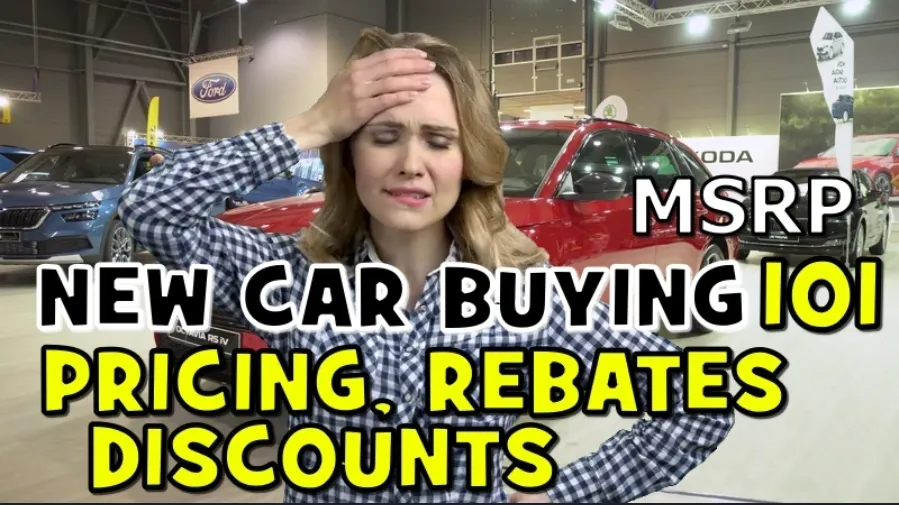NEW CAR BUYING 101

New Car Buying 101
Content written by The Homework Guy, Kevin Hunter, and Amazing Elizabeth, The Homework Gal.
For a thorough discussion on video, see this link: https://youtu.be/aFQkb7GUCpY
Everything you need to know about Pricing, Rebates, Discounts, and Addendums if you’re a New Car Buyer!
“Are you ready to drive off the lot in a brand new car without getting taken for a ride by a dealer? If so, you’re in the right place! We are here to steer you right! Buckle up, because we’re about to share our most comprehensive report on new car buying we’ve ever done, and in doing so, we’ll take a high-speed tour through everything you need to know about buying a new car at a dealership!” So, let’s rock and roll!
What do New Cars actually cost the Dealer?
One thing that’s for sure, it’s definitely NOT the MSRP, so when a dealer tells you “We are losing money” with a new vehicle priced right near MSRP, they are always full of it. Another type of dealer that’s totally full of it is a dealer still holding onto a market adjustment for his new car inventory saying, We have a Shortage! Just laugh very loudly, and move along to a more reasonable dealer if that is still happening near you. The true cost of a new car to a dealer is not simply the dealer invoice price which most people have commonly heard about. But, there’s more to it than that!
Also involved in the picture are additional financial benefits such as hold-backs and factory-to-dealer incentives. While it’s true that the invoice price is commonly referred to as the dealer cost, and many dealers have stopped sharing the invoice with you, you should know that You can often get Invoice pricing from some websites, like Greg Fidan’s https://www.realcartips.com/. We think Greg’s site is awesome!
You should also know that the actual dealer invoice price is often reduced much lower before the dealer ends up paying for it, due to various rebates, incentives, and other discounts that the manufacturer provides to the dealer. These discounts and incentives are applied directly to the dealer’s invoice price and reduce the amount of the money due to the manufacturer. For example, there’s the well known dealer HOLD-BACK, which is a percentage of the car’s MSRP that is paid back to the dealer by the manufacturer.
Car dealers may actually sell vehicles for less than the invoice price due to these additional incentives and discounts. These financial arrangements between manufacturers and dealers are often not disclosed to buyers.
For you, the car buyer, to get anywhere near dealer invoice price these days, you must exercise patience, good timing, and a willingness to pit one dealer against another (as seen on our video TIMING IS EVERYTHING). We highly recommend you use this excellent technique that is one of my favorites.
But, if you take away Holdback from Invoice, and subtract other incentives, that’s not the end of the income stream for Dealers on their new cars.
Why? Because, there’s another way that dealers make money on their new cars. It’s known as Dealer Floor Plan Financing. Dealer floor plan financing is a system that allows auto dealers to borrow money from lenders to finance their inventory of vehicles, and there’s a number of ways this can be profitable for dealers:
- Inventory Financing: Floor plan financing provides dealers with the funds to acquire inventory, whether purchasing cars at an auction or from the manufacturer, without paying upfront. This means dealers can maintain a large selection of vehicles on their lots, which they can sell to customers at retail prices.
- Cash Flow Management: Dealers do not owe anything on the floor plan line of credit until their first contracted payment, which is usually a small portion of the total vehicle cost. This allows dealers to manage their cash flow more effectively, as they can sell the vehicles before the full payment to the lender is due. Moving a vehicle before it incurs this expense can be attractive to a dealer.
- Revolving Credit Lines: The floor plan is a revolving line of credit, which means that as dealers sell their inventory, they can use the proceeds to pay off the loan and then borrow again to replenish their inventory. This creates a continuous cycle of buying and selling without the need for large amounts of capital.
- Secured Loans: The loans are often secured by the inventory itself, meaning that until the cars are sold to the end-users, the lender retains the titles. This reduces the risk for the lender and allows the dealer to obtain financing on favorable terms.
- Using Lender’s Money to Earn Profit: By using the lender’s money, the dealer can typically sell the vehicles for more than the amount borrowed plus any interest and fees they collect. The difference between the loan amount and the sales price, minus the costs, represents the dealer’s profit.
As you can see, through floor plan financing, dealers can stock a wide range of vehicles, sell them for a profit, and use the proceeds to pay back the loan and finance additional inventory, effectively leveraging the lender’s money (somebody else’s money) in a never ending cycle to generate income.
Manufacturer Rebates and How they work:
Manufacturer rebates are financial incentives offered by car manufacturers to encourage consumers to purchase a particular type of vehicle. They effectively reduce the price of a new car. Here’s how they work:
- The Purpose of Rebates: Rebates and incentives stimulate sales of specific makes and models of new cars or trucks. They are used to increase sales volume in specific models, move older inventory, introduce new models, and maintain brand loyalty.
- There’s Eligibility Requirements: To qualify for a rebate, there may be specific conditions to be met. These can include different types of professions (work careers), and may include a requirement to finance the vehicle through the automaker’s financing company, or already being the owner or leasee of a vehicle from the manufacturer, or other specific criteria set by the manufacturer.
- Rebate Types: There are different types of rebates such as manufacturer’s rebates, dealership rebates, and government rebates. Manufacturer’s rebates are offered directly by the car manufacturer and are applied at the time of purchase, and can be sometimes used as a down payment on the vehicle. Government Rebates most commonly come in the form of a Tax Credit to incentivize certain vehicle purchases, like EV’s we’ve seen recently.
- There’s the Application of Rebates: Rebates are typically applied as a reduction in the purchase price of the vehicle, effectively lowering the total amount financed.
- Of course, we can’t forget Advertised Discounts: Rebates are often advertised as cash offers, such as “bonus cash” or “cash-back,” and are intended to seem like a direct way to save money on a new vehicle purchase.
In summary, rebates are discounts provided by the manufacturer that reduce the purchase price of a new vehicle for the buyer. They are a common promotional tool used to incentivize buyers and can vary a lot based on the manufacturer’s sales strategies and market objectives.
Dealer Cash.
Dealer cash is a type of incentive provided by car manufacturers to dealerships. Here’s a breakdown of how it works:
- It’s an Incentive for Selling Specific Models: Manufacturers pay dealer cash to dealerships as an incentive for selling certain models of cars. This is done to stimulate sales of that particular model.
- Flexibility in Pricing: Dealer cash enables dealers to sell cars at lower prices than they would be able to without the incentive. This can make certain models more attractive to buyers due to the lower price point.
- Dealer’s Discretion: Unlike a rebate, dealers are not obligated to pass the savings from dealer cash on to the consumer. They have the option to either offer the car at a reduced price or keep the savings as additional profit. The incentive is typically intended to increase car sales by giving dealers more flexibility in pricing.
- Reduction in Dealer Cost: Dealer cash is similar to a rebate that is applied to the dealer’s side of the transaction. It reduces the cost that the dealer has to pay for the vehicle, effectively lowering the dealer’s purchase price from the manufacturer.
Dealer cash differs from consumer rebates and incentives in that it is not directly advertised to the public and may not be disclosed at all during the sales process.
Dealer addendums
Dealer addendums are additional cost stickers placed on a car at a dealership, usually right next to the Window sticker. These addendums show parts or services added by the dealer.
Dealer Addendums, while being a very common tactic by new car dealers, tip-toes the line of Illegal Tied Selling or forced Add ons. We often recommend that you argue against paying for them.
Unfortunately, there’s no regulation on how much can be charged for these add-ons, so they can be reasonable or very excessive. The value of dealer add-ons are always subjective.
To determine a fair offer, comparing the dealer invoice pricing with real-world sales information available in the market is advisable. This helps in setting a “walk away” price and negotiating any add-ons listed on the dealer addendum.
It is also recommended to be aware that not every vehicle can be negotiated below the addendum sticker price, especially for limited-production or high-demand cars.
How much Dealer Discount can be expected on a new Car Purchase?
The amount of dealer discount you can expect depends on several factors, including the vehicle’s market value, demand, and the dealer’s willingness to negotiate (how hungry they are to move the vehicle you’re on).
During the pandemic, due in part to vehicle shortages, no discounts of any kind were to be had. But, as of the date of this show, new car inventory had reached 2.4 million cars, a level that many experts didn’t expect to happen again, especially not this soon.
But, given a more normal inventory level of new cars like we have now, here’s a General Rule of Thumb: A common starting point is to offer 3-5% over the dealer’s cost for the new car. You can use resources like Kelley Blue Book https://www.kbb.com/, Consumer Reportshttps://www.consumerreports.org/cars/, or Edmund’s True Market Value https://www.edmunds.com/tmv.html to determine the invoice price for the specific make and model you’re interested in. As we’ve said before, a source of new car buying information we find equally credible is Greg Fidan’s https://www.realcartips.com/
Here’s The Current Discount Range: Unless the vehicle is in high demand or a trendy model, a discount off MSRP of 3-5% on a new vehicle is often considered reasonable. Even a 7.5% discount is doable by skilled negotiators who practice patience and effectively use TIMING. See our video on the subject. If the vehicle is a slow mover, the potential discount could be as high as 10-15%.
- High-Demand Vehicles: For cars that are in high demand, you might be able to negotiate a discount of about 2 to 5%.
- Market Conditions also drive this: The market value of the car and current market conditions will influence how much profit a dealer is willing to give up to make a sale. Sometimes, it might be possible to negotiate a purchase at the invoice price, especially if there’s plenty of inventory and low demand for the car.
When negotiating, it’s also important to consider any manufacturer rebates or incentives that could further reduce the price. Always do thorough research and be prepared to discuss pricing armed with the latest market data. If you do this, you’ll have the best chance at securing a significant discount. If you’re concerned about being pushed into dealer add ons, make sure you see our video on Laws (Federal and State) to know about.
Why vehicle time in inventory matters
The time a vehicle spends in a dealership’s inventory matters for several reasons:
- Depreciation: Cars depreciate over time. The longer a vehicle sits on a dealership lot, the more it depreciates in value. Dealerships want to sell cars before substantial depreciation occurs.
- Costs: Dealerships incur costs for each car in their inventory, including insurance, interest on loans used to purchase the inventory (floor planning), and space on the lot. Each spot for a car on a dealer’s lot is worth a given amount of money. Selling vehicles more quickly reduces these holding costs.
- Cash Flow: The quicker a dealer can turn over their inventory, the better their cash flow. This turnover allows dealers to reinvest in new inventory and maintain a fresh selection for customers.
- Manufacturer Incentives: Manufacturers often provide incentives to dealers to sell cars within a certain timeframe. If cars are not sold in that window, the dealership may lose out on these incentives.
- Market Trends: Consumer preferences and market trends can change rapidly making inventory value go up and down. Vehicles that remain unsold can become less desirable if they no longer meet consumer demands or if newer models are released.
- Negotiation Leverage: Vehicles that have been in inventory for an extended period may provide negotiation leverage for buyers. Dealerships may be more willing to offer discounts to move these cars off the lot. Oftentimes you only need to ask about aged Inventory.
Dealerships track the time each vehicle spends in inventory closely and often have strategies to reduce this time to ensure profitability and operational efficiency.
Friends, If you feel you lack the skills to negotiate a new car purchase with the information we’ve presented to you, and you’d like our direct help, just join our YouTube channel as a member today and get direct help from me or Kevin.
Here’s the link: https://www.youtube.com/channel/UCJ6Su-8bINvXVXWf0peAIJg/join



